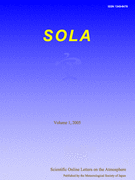Catastrophic disasters triggered by mesoscale convective systems occur annually in East Asia, with a notable increase in casualties and extensive damages between 2019 and 2021 due to record-breaking rainfall in Japan. There is an urgent need for a comprehensive understanding of the physical processes and dynamic mechanisms behind these extreme rainfall events. This requires the integration of various research approaches, including observational analysis, statistical data analysis, and weather forecasting with data assimilation. Additionally, we must consider the impact of large-scale atmospheric circulation on extreme weather in East Asia. In this special edition, jointly coordinated with
Journal of the Meteorological Society of Japan, we have published nine articles covering extreme events in East Asia from 2017 to 2022. Here, we provide an overview of these papers.
From a large-scale view perspective, Horinouchi et al. (2021) and Ueda et al. (2021) examined the influence of synoptic-scale moisture conditions and sea surface temperatures on severe rainfall events in Kyushu, Japan during the summer of 2020. Additionally, Takemura et al. (2022) investigated the large-scale atmospheric factors contributing to the record-breaking early onset of Baiu season in most parts of western Japan in 2021. Furthermore, Kuramochi et al. (2021) conducted a study on the causes of the anomalous warm conditions in winter 2019 and 2020 over East Asia, utilizing large-scale atmospheric analysis and global simulations.
Three papers focused on the statistical features of environmental conditions suitable for the occurrence of “senjo-kousuitai” (Kato 2020). Goto and Satoh (2022) applied a similar definition of senjo-kousuitai as proposed by Kato 2020 to a satellite-based precipitation dataset covering 20 years from 2000 to 2019. They confirmed a high occurrence frequency in Kyushu, the Nansei Islands (South of Kyushu), and the East China sea. Based on analysis using reanalysis datasets, it was determined that low-level water vapor flux and vertical wind shear are essential for the development of senjo-kousuitai. Sato and Hosotani (2023) also confirmed the importance of these two factors based on reanalysis data spanning the past 20 years. Additionally, Naka and Takemi (2023) proposed the significance of moist absolutely unstable layers (MAULs) in enhancing heavy rainfall in the preceding hours.
Numerical simulations were also employed in research efforts. Tochimoto et al. (2022) conducted sensitivity experiments to investigate the impact of the upper-level trough on the heavy rainfall. In another study, Terasaki and Miyoshi (2022) demonstrated the high predictability of heavy rainfall by utilizing data assimilation with 1024-ensemble members. Doyle et al. (2023) indicated the importance of a mesoscale convective system, orographic ascent, and equatorial wave components in contributing to the extreme flood that occurred in southwestern Sulawesi, Indonesia in January 2019 by conducting adjoint model simulations and the sensitivity analysis.
To mitigate the damages caused by various extreme weather events, it is essential to consolidate our research achievements and further enhance the predictability of these events.
View full abstract
